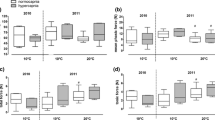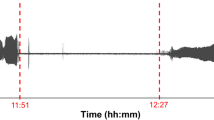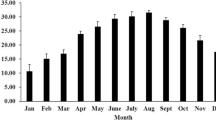Abstract
The ongoing process of ocean acidification already affects marine life, and according to the concept of oxygen and capacity limitation of thermal tolerance, these effects may be intensified at the borders of the thermal tolerance window. We studied the effects of elevated CO2 concentrations on clapping performance and energy metabolism of the commercially important scallop Pecten maximus. Individuals were exposed for at least 30 days to 4 °C (winter) or to 10 °C (spring/summer) at either ambient (0.04 kPa, normocapnia) or predicted future PCO2 levels (0.11 kPa, hypercapnia). Cold-exposed (4 °C) groups revealed thermal stress exacerbated by PCO2 indicated by a high mortality overall and its increase from 55 % under normocapnia to 90 % under hypercapnia. We therefore excluded the 4 °C groups from further experimentation. Scallops at 10 °C showed impaired clapping performance following hypercapnic exposure. Force production was significantly reduced although the number of claps was unchanged between normocapnia- and hypercapnia-exposed scallops. The difference between maximal and resting metabolic rate (aerobic scope) of the hypercapnic scallops was significantly reduced compared with normocapnic animals, indicating a reduction in net aerobic scope. Our data confirm that ocean acidification narrows the thermal tolerance range of scallops resulting in elevated vulnerability to temperature extremes and impairs the animal’s performance capacity with potentially detrimental consequences for its fitness and survival in the ocean of tomorrow.




Similar content being viewed by others
References
Ansell A, Dao JC, Manson J (1991) Three European scallops: Pecten maximus, Chlamys (Aequipecten) opercularis and C. (Chlamys) varia. In: Shumway SE (ed) Scallops: biology, ecology and aquaculture, 1st edn. Elsevier, Amsterdam, pp 715–752
Bailey DM, Peck LS, Bock C, Pörtner HO (2003) High-energy phosphate metabolism during exercise and recovery in temperate and Antarctic scallops: an in vivo 31P-NMR study. Physiol Biochem Zool 76(5):622–633. doi:10.1086/376920
Bailey DM, Johnston IA, Peck LS (2005) Invertebrate muscle performance at high latitude: swimming activity in the Antarctic scallop, Adamussium colbecki. Polar Biol 28:464–469. doi:10.1007/s00300-004-0699-9
Beniash E, Ivanina A, Lieb NS, Kurochkin I, Sokolova IM (2010) Elevated levels of carbon dioxide affect metabolism and shell formation in oysters Crassostrea virginica. Mar Ecol Prog Ser 419:95–108
Booth CE, McDonald DG, Walsh PJ (1984) Acid-base balance in the sea mussel, Mytilus edulis. I. Effects of hypoxia and air-exposure on hemolymph acid-base status. Mar Biol Lett 5:347–358
Brand AR (2006) Scallop ecology: distributions and behaviour. In: Shumway SE, Parson GJ (eds) Scallops: biology ecology and aquaculture, 1st edn. Elsevier, Amsterdam, pp 651–744. doi:10.1016/S0167-9309(06)80034-7
Brock V, Kennedy VS, Brock A (1986) Temperature dependency of carbohydrase activity in the hepatopancreas of thirteen estuarine and coastal bivalve species from the North American east coast. J Exp Mar Biol Ecol 103:87–101
Caldeira K, Wickett ME (2003) Anthropogenic carbon and ocean pH. Nature 425:365
Chih CP, Ellington WR (1983) Energy metabolism during contractile activity and environmental hypoxia in the adductor muscle of the Bay Scallop Argopecten irradians concentricus. Physiol Zool 56(4):623–631
de Zwaan A, Thompson RJ, Livingston DR (1980) Physiological and biochemical aspects of the valve snap and valve closure responses in the giant scallop Placopecten magellanicus II. Biochemistry. J Comp Physiol B 137:105–114
Denny M, Miller L (2006) Jet propulsion in the cold: mechanics of swimming in the Antarctic scallop Adamussium colbecki. J Exp Biol 209:4503–4514. doi:10.1242/jeb.02538
Dickinson GH, Ivanina AV, Matoo OB, Pörtner HO, Lannig G, Bock C, Beniash E, Sokolova IM (2012) Interactive effects of salinity and elevated CO2 levels on juvenile eastern oysters, Crassostrea virginica. J Exp Biol 215:29–43. doi:10.1242/jeb.061481
Dickson AG, Millero FJ (1987) A comparison of the equilibrium constants for the dissociation of carbonic acid in seawater media. Deep-Sea Res 34(111):1733–1743
Doney SC, Fabry VJ, Feely RA, Kleypas JA (2009) Ocean acidification: the other CO2 problem. Annu Rev Mar Sci 1:169–192
Epp J, Bricelj VM, Malouf RE (1988) Seasonal partitioning and utilization of energy reserves in two age classes of the bay scallop Argopecten irradians irradians (Lamarck). J Exp Mar Biol Ecol 121:113–136
Fabry VJ, Seibel BA, Feely RA, Orr JC (2008) Impacts of ocean acidification on marine fauna and ecosystem processes. ICES J Mar Sci 65:414–432
Findlay HS, Kendall MA, Spicer JI, Widdicombe S (2010) Relative influence of ocean acidification and temperature on intertidal post-larvae at the northern edge of their geographic distribution. Estuar Coast Shelf Sci 86:675–682
Fleury P-G, Janssoone X, Nadeau M, Guderley H (2005) Force production during escape responses: sequential recruitment of the phasic and tonic portions of the adductor muscle in juvenile sea scallop, Placopecten magellanicus (Gmelin). J Shellfish Res 24(4):905–911. doi:10.2983/0730-8000(2005)24[905:FPDERS]2.0.CO;2
Fry FE (1947) Effects of the environment on animal activity. Univ Toronto biol Ser 55. Pub Ont Fish Res Lab 68:1–62
Gäde G, Weeda E, Gabbott PA (1978) Changes in the level of octopine during the escape responses of the scallop, Pecten maximus (L.). J Comp Physiol 124:121–127
Grieshaber M, Gäde G (1977) Energy supply and the formation of octopine in the adductor muscle of the scallop, Pecten jabobaeus (Lamarck). Comp Biochem Physiol B 58:249–252
Gruffydd LD (1976) Swimming in Chlamys islandica in relation to current speed and an investigation of hydrodynamic lift in this and other scallops. Nor J Zool 24:365–378
Guderley H, Pörtner HO (2010) Metabolic power budgeting and adaptive strategies in zoology: examples from scallops and fish. Can J Zool 88:753–763
Guderley H, Labbé-Giguere S, Janssoone X, Bourgeois M, Pérez HM, Tremblay I (2009) Thermal sensitivity of escape response performance by the scallop Placopecten magellanicus: impact of environmental history. J Exp Mar Biol Ecol 377:113–119
Haya K, Waiwood BA, van Eeckhaute L (1985) Disruption of energy metabolism and smoltification during exposure of juvenile Atlantic salmon (Salmo salar) to low pH. Comp Biochem Physiol C 82(2):323–329
Heilmayer O, Brey T (2003) Saving by freezing? Metabolic rates of Adamussium colbecki in a latitudinal context. Mar Biol 143:477–484. doi:10.1007/s00227-003-1079-7
IPCC (2007) Climate Change 2007: the physical science basis. Summary for policymakers. Contribution of working group I to the fourth assessment report. The intergovernmental panel on climate change. www.ipcc.ch/SPM2feb07.pdf
Kroeker KJ, Kordas RL, Crim RN, Singh GG (2010) Meta-analysis reveals negative yet variable effects of ocean acidification on marine organisms. Ecol Lett 13:1419–1434
Langenbuch M, Pörtner HO (2003) Energy budget of hepatocytes from Antarctic fish (Pachycara brachycephalum and Lepidonotothen kempi) as a function of ambient CO2: pH-dependent limitations of cellular protein biosynthesis? J Exp Biol 206:3895–3903
Langenbuch M, Pörtner HO (2004) High sensitivity to chronically elevated CO2 levels in a eurybathic marine sipunculid. Aquat Toxicol 70:55–61. doi:10.1016/j.aquatox.2004.07.006
Lannig G, Eilers S, Pörtner HO, Sokolova IM, Bock C (2010) Impact of ocean acidification on energy metabolism of oyster, Crassostrea gigas—changes in metabolic pathways and thermal response. Mar Drugs 8:2318–2339. doi:10.3390/md8082318
Lewis E, Wallace DWR (1998) CO2SYS-Program developed for the CO2 system calculations. Carbon dioxide information analysis center; Report ORNL/CDIAC-105, Oak Ridge, Tenn, USA
Lindinger MI, Lawren DJ, McDonald DG (1984) Acid–base balance in the sea mussel Mytilus edulis. Effects of environmental hypercapnia on intra and extracellular acid–base balance. Mar Biol Lett 5:371–381
MacDonald BA, Bricelj VM, Shumway SE (2006) Physiologie: energy acquisition and utilisation. In: Shumway SE, Parson GJ (eds) Scallops: biology, ecology and aquaculture, 1st edn. Elsevier, Amsterdam, pp 417–492. doi:10.1016/S0167-9309(06)80034-7
Mackay J, Shumway SE (1980) Factors affecting oxygen consumption in the scallop Chlamys deliculata (Hutton). Ophelia 19:19–26
Mehrbach C, Culberson CH, Hawley JE, Pytkowicz RM (1973) Measurement of the apparent dissociation constants of carbonic acid in seawater at atmospheric pressure. Limnol Oceanogr 18(6):897–907
Melatunan S, Calosi P, Rundle SD, Moody AJ, Widdicombe S (2011) Exposure to elevated temperature and PCO2 reduces respiration rate and energy status in the Periwinkle Littorina littorea. Physiol Biochem Zool 84(6):583–594. doi:10.1086/662680
Melzner F, Gutowska MA, Langenbruch M, Dupont S, Lucassen M, Thorndyke MC, Bleich M, Pörtner HO (2009) Physiological basis for high CO2 tolerance in marine ectothermic animals: pre-adaptation through lifestyle and ontogeny? Biogeosciences 6:2313–2331
Melzner F, Stange P, Trübenbach K, Thomsen J, Casties I, Panknin U, Gorb SN, Gutowska A (2011) Food supply and seawater pCO2 impact calcification and internal shell dissolution in the blue mussel Mytilus edulis. PLoS ONE 6(9):e24223. doi:10.1371/journal.pone.0024223
Metzger R, Sartoris F, Langenbuch M, Pörtner HO (2007) Influence of elevated CO2 concentrations on thermal tolerance of the edible crab Cancer pagurus. J Therm Biol 32(3):144–151. doi:10.1016/j.jtherbio.2007.01.010
Michaelidis B, Ouzounis C, Paleras A, Pörtner HO (2005) Effects of long-term moderate hypercapnia on acid–base balance and growth rate in marine mussels Mytilus galloprovincialis. Mar Ecol Prog Ser 293:109–118
Orr JC (2011) Recent and future changes in ocean carbonate chemistry. In: Gattuso J-P, Hansson L (eds) Ocean acidification. Oxford University Press, Oxford, pp 41–66
Parker LM, Ross PM, O′Connor WA (2009) The effect of ocean acidification and temperature on the fertilization and embryonic development of the Sydney rock oyster Saccostrea glomerata (Gould 1850). Glob Change Biol 15:2123–2136. doi:10.1111/j.1365-2486.2009.01895.x
Pazos AJ, Román G, Acosta CP, Abad M, Sánchez JL (1997) Seasonal changes in condition and biochemical composition of the scallop Pecten maximus L. from suspended culture in the Ria de Arousa (Galicia, N.W., Spain) in relation to environmental conditions. J Exp Mar Biol Ecol 211:169–193
Pfeil B, Olsen A, Bakker DC et al. (2012) A uniform, quality controlled, Surface Ocean CO2 Atlas (SOCAT). Earth system science data (in preparation). http://www.socat.info/. Accessed 29 Mar 2012
Philipp EE, Schmidt M, Gsottbauer C, Sänger AM, Abele D (2008) Size- and age-dependent changes in adductor muscle swimming physiology of the scallop Aequipecten opercularis. Mar Ecol Prog Ser 389:193–202. doi:10.3354/meps08141
Pörtner HO (1987) Contributions of anaerobic metabolism to pH regulation in animal tissues: theory. J Exp Biol 131:69–87
Pörtner HO (2002) Environmental and functional limits to muscular exercise and body size in marine invertebrate athletes. Comp Biochem Physiol A 133:303–321
Pörtner HO (2008) Ecosystem effects of ocean acidification in times of ocean warming: a physiologist’s view. Mar Ecol Prog Ser 373:203–217. doi:10.3354/meps07768
Pörtner HO (2010) Oxygen- and capacity-limitation of thermal tolerance: a matrix for integrating climate-related stressor effects in marine ecosystems. J Exp Biol 213:881–893. doi:10.1242/jeb.037523
Pörtner HO, Bock C (2000) A contribution of acid-base regulation to metabolic depression in marine ectotherms. In: Heldmaier G, Klingenspor M (eds) Life in the cold, 1st edn. Springer, Berlin, pp 443–458
Pörtner HO, Farrell AP (2008) Physiology and climate change. Science 322:690–692
Pörtner HO, Reipschläger A, Heisler N (1998) Metabolism and acid-base regulation in Sipunculus nudus as a function of ambient carbon dioxide. J Exp Biol 201:43–55
Pörtner HO, Bock C, Reipschläger A (2000) Modulation of the cost of pHi regulation during metabolic depression: a 31P-NMR study in invertebrate (Sipunculus nudus) isolated muscle. J Exp Biol 203:2417–2428
Pörtner HO, Langenbuch M, Reipschläger A (2004) Biological impact of elevated ocean CO2 concentrations: lessons from animal physiology and earth history. J Oceanogr 60:705–718
Riisgård HU, Larsen PS (2007) Viscosity of seawater controls beat frequency of water-pumping cilia and filtration rate of mussels Mytilus edulis. Mar Ecol Prog Ser 343:141–150. doi:10.3354/meps06930
Scheibling RE, Hatcher BG, Taylor L, Barbeau MA (1995) Seeding trial of the giant scallop (Placopecten magellanicus) in Nova Scotia. In: Lubet P, Barret J, Dao J-C (eds) Fisheries, biology and aquaculture of Pectinids. 8th International Pectinid Workshop, Cherbourg, France, 22nd–29th May, 1991, IFREMER, Actes de Colloques 17:123–129
Shriver AC, Carmichael RH, Valiela I (2002) Growth, condition, reproductive potential, and mortality of bay scallops, Argopecten irradians, in response to eutrophic-driven changes in food resources. J Exp Mar Biol Ecol 279:21–40
Sokolova IM, Frederich F, Bagwe R, Lannig G, Sukhotin AA (2012) Energy homeostasis as an integrative tool for assessing limits of environmental stress tolerance in aquatic invertebrates. Mar Environ Res 79:1–15. doi:10.1016/j.marenvres.2012.04.003
Strand Ø, Brynjeldsen E (2003) On the relationship between low winter temperatures and mortality of juvenile scallops, Pecten maximus L., cultured in western Norway. Aquacult Res 34:1417–1422
Strand Ø, Nylund A (1991) The reproductive cycle of the scallop Pecten maximus (L.) from two populations in Western-Norway, 60 N and 64 N. In: Shumway SE (ed) An international compendium of scallop biology and culture. Special Publication, World Aquaculture Society, Baton Rouge, pp 95–105
Stumpp M, Wren J, Melzner F, Thorndyke MC, Dupont S (2011) CO2 induced acidification impacts sea urchin larval development I: elevated metabolic rates decrease scope for growth and induce developmental delay. Comp Biochem Physiol A 160:331–340. doi:10.1016/j.cbpa.2011.06.022
Thompson RJ, Livingstone DR, de Zwaan A (1980) Physiological and biochemical aspects of the valve snap and valve closure responses in the giant scallop Placopecten magellanicus I. Physiology. J Comp Physiol 137:97–104
Tremblay R, Myrand B, Guderley H (1998) Thermal sensitivity of organismal and mitochondrial oxygen consumption in relation to susceptibility of blue mussels, Mytilus edulis (L.), to summer mortality. J Shellfish Res 17:141–152
Tremblay I, Guderley HE, Fréchette M (2006) Swimming performance, metabolic rates, and their correlates in the Iceland scallop Chlamys islandica. Physiol Biochem Zool 79(6):1046–1057
Walsh PJ, McDonald G, Booth CE (1984) Acid-base balance in the sea mussel, Mytilus edulis. II. Effects of hypoxia and air-exposure on the intracellular acid-base status. Mar Biol Lett 5:359–369
Walther K, Sartoris FJ, Bock C, Pörtner HO (2009) Impact of anthropogenic ocean acidification on thermal tolerance of the spider crab Hyas araneus. Biogeosciences 6:2207–2215
Weiss RF (1974) Carbon dioxide in water and seawater: the solubility of a non-ideal gas. Mar Chem 2:203–215
Wiborg KF (1963) Some observations on the Iceland scallop Chlamys islandica (Müller) in Norwegian waters. Fiskeridirecktoratets Skrifter. Serie Havundersøkelser 13:38–53
Wieser W, Medgyesy N (1990) Cost and efficiency of growth in the larvae of two species of fish with widely differing metabolic rates. Proc Biol Sci 242(1303):51–56
Wilkens LA (2006) Neurobiology and behaviour of the scallop. In: Shumway SE, Parson GJ (eds) Scallops: biology, ecology and aquaculture, 1st edn. Elsevier, Amsterdam, pp 317–356. doi:10.1016/S0167-9309(06)80034-7
Winter MA, Hamilton PV (1985) Factors influencing swimming in Bay Scallops, Argopecten irradians (Lamarck, 1819). J Exp Mar Biol Ecol 88:227–242
Wood H, Spicer JI, Widdicombe S (2008) Ocean acidification may increase calcification rates, but at a cost. Proc R Soc Lond B 275:1767–1773
Zittier ZM, Hirse T, Pörtner HO (2012) The synergistic effects of increasing temperature and CO2 levels on activity capacity and acid-base balance in the spider crab, Hyas araneus. Mar Biol. doi:10.1007/s00227-012-2073-8
Acknowledgments
We would like to thank Øivind Strand and the aquaculture Kvitsøy Edelskjell AS for their support in animal supply. We also gratefully acknowledge the support of M. Bullwinkel, N. Klassen and C. Otten, who assisted in animal care and water analysis during the incubation experiments. We thank O. Heilmayer for helpful discussion, Are Olsen for supporting information on PCO2 values around Stavanger and E. Schaum for language check. We thank the two anonymous reviewers and the editor, Sam Dupont, for their constructive comments on the manuscript. Burgel Schalkhausser was funded by the Bundesministerium für Bildung und Forschung (BMBF)-funded project “Biological Impacts of Ocean Acidification” (BIOACID, FKZ 03F0608B). The study is part of the “Polar regions and coasts in a changing Earth system” (PACES) research programme of the Alfred Wegener Institute for Polar and Marine Research.
Author information
Authors and Affiliations
Corresponding author
Additional information
Communicated by S. Dupont.
Rights and permissions
About this article
Cite this article
Schalkhausser, B., Bock, C., Stemmer, K. et al. Impact of ocean acidification on escape performance of the king scallop, Pecten maximus, from Norway. Mar Biol 160, 1995–2006 (2013). https://doi.org/10.1007/s00227-012-2057-8
Received:
Accepted:
Published:
Issue Date:
DOI: https://doi.org/10.1007/s00227-012-2057-8




